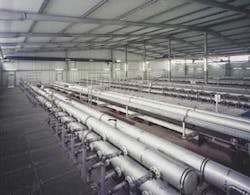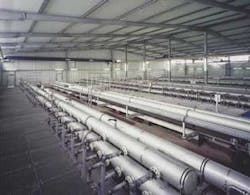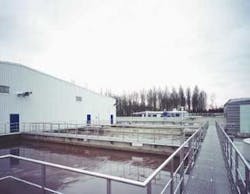Membrane bioreactors restore health of German waterways
Membrane bioreactors improve water quality dramatically in the Nordcanal, enough to spur city officials in Kaarst, Germany to develop plans for tourism and recreational opportunities.
Membrane bioreactors (MBRs) are increasingly being used throughout Europe, providing communities with cleaner rivers, lakes, groundwater and coastal beaches. Many European water companies are considering and commissioning MBRs to treat municipal wastewater to a very high quality that meet tough new European water standards for safe water discharge to the environment.
For two communities in the German state of North Rhine-Westphalia-Rödingen and the City of Kaarst-MBRs are not only efficiently and economically handling wastewater, but the effluent they discharge is improving the state of the natural environment. Waterways that were becoming increasingly polluted from poorly performing conventional wastewater treatment plants are being cleaned up and bringing many benefits to communities and downstream portions of the watershed.
The German water management company Erftverband was the first in Germany to turn to MBR technology for wastewater treatment. In December 2003, the company commissioned Europe's largest immersed, ultrafiltration MBR facility at Nordkanal in Kaarst, Germany to treat up to 48,000 m3 of wastewater per day.
Erftverband is a public corporation and has been responsible for nearly 50 years for the conservation and management of all surface waters and flood protection in the Erft River watershed. It also handles about 50 wastewater treatment plants and sewage sludge removal for municipalities in the German state of North Rhine-Westphalia.
Erftverband commissioned the first full-scale MBR on the European continent in June 1999 as part of its strategy to preserve and improve the water quality in the Erft River watershed, and to conform to government regulations. The plant treats municipal wastewater for the small community of Rödingen located about 50 km southwest of Düsseldorf. The community's original treatment plant was constructed in 1974 to serve 3,000 person equivalents (PE.), but the aging conventional plant needed upgrading after almost 25 years of service to ensure regulatory compliance.
The company employed MBR technology to ensure that the Rödingen plant would produce high quality effluent that meets the requirements of the European Union Bathing Water regulations and protect the Finkel Stream - a small, environmentally sensitive waterway that receives effluent from the plant. Erftverband selected a ZENON ZeeWeed® MBR for Rödingen as the best available technology for a new facility, rather than constructing an additional activated sludge basin and final clarifier.
Several other features of the system also made it a more attractive option. MBRs are more economical than conventional technology to operate on a lifecycle basis, offer highly automated operation, can be expanded rapidly to accommodate community growth, and occupy a significantly smaller footprint.
A conventional system would have required a large flocculation tank and large aeration basins; however the entire ZeeWeed MBR at Rödingen occupies a footprint of only 42 m x 13 m. Capable of treating up to 3,240 m3 of wastewater per day, the system includes two bioreactors that alternate in performing the denitrification and nitrification phases and two immersed microfiltration membrane units. The treated effluent from the plant typically has COD of less than 20 mg/L, BOD of less than 5 mg/L, NH4-N of less than 1 mg/L, and Ptot,inorg. of less than 0.5 mg/L.
During the dry season, effluent from Rödingen provides much of the water that flows through the Finkel Stream, so effluent must be of extremely high quality to avoid harming the plants and animals that live in and around the stream. The Bathing Water Quality standard specifies total coliforms less than 500/100 ml, faecal coliforms of 100/100 ml, and salmonella 0/1000 ml. MBR systems can treat wastewater to this standard and can safely discharge effluent to the natural environment without the addition of disinfectant chemicals.
Following the successful implementation of the MBR and five years of successful operation at Rödingen, Erftverband faced a similar situation at its Nordkanal wastewater treatment plant located in the nearby city of Kaarst. The conventional facility, designed for 65,000 PE, was unable to meet new discharge standards when operating at peak capacity. Consequently, the Nordkanal became heavily polluted from the discharged effluent. In addition, the plant needed to be expanded to meet the wastewater treatment demands of the growing community.
Nordkanal is a small artificial canal about 53 km in length that Napoleon ordered to be constructed in the early 1800s to connect the Rhine River in Germany with the Maas River in The Netherlands. Since 1974 it has functioned as a receiving creek for the effluent from the Kaarst wastewater treatment plant; however the canal is very susceptible to accumulating pollutants since it flows very slowly and is virtually standing water.
The ministers of environmental affairs from Germany and North-Rhine Westphalia agreed that a higher quality of effluent must be discharged into the Nordkanal to reduce pollution and improve overall water quality of the canal. North-Rhine Westphalia's European Garden (EUROGA) initiative with the Netherlands also sought to improve the Nordkanal to strengthen cultural and environmental relations between the regions. EUROGA includes 58 cities and municipalities in the area of Düsseldorf, Mönchengladbach and in the Dutch province of Limburg, which participated in about 120 projects.
The existing plant employed conventional activated sludge technology that included primary clarification, nitrification, denitrification and sedimentation tanks. The plant could be expanded using the same conventional technology, but this strategy would not address the need to improve the quality of the effluent flowing into Nordkanal and would require a large portion of the surrounding forest to be cleared for the new buildings.
Drawing from its experience with the MBR at Rödingen, Erftverband began exploring the possibility of constructing a much larger MBR plant at Nordkanal. Working with a local engineering company, Erftverband began an extensive evaluation process to select the best available technology with minimum footprint to serve the growing population of Kaarst, and to restore the water quality in the Nordkanal. At the end of the tendering and evaluation period, Erftverband once again selected ZENON ZeeWeed ultrafiltration membranes for its new 80,000 PE MBR plant.
Capable of treating up to 48,000 m3/day of wastewater, the new MBR plant was constructed about two kilometres upstream from the old conventional plant, and occupies only about 45% of the land that a conventional plant would require. The smaller footprint of the new plant spared about 25,000 m2 of forest from being cut down.
Wastewater from Kaarst is passed through a 5-mm step screen at the headworks of the plant. Influent then passes through an aerated sand filter, followed by 0.5-mm fine screen. Primary sedimentation is not required in the MBR process and the absence of this equipment reduces the overall footprint of the Nordkanal facility.
Ferric chloride is added to the raw water, which then flows by gravity to the anoxic zone of the bioreactor where most denitrification occurs. In the next step, the mixed liquor flows to an aerobic/anoxic swing zone and finally to an aerobic zone for nitrification. ZeeWeed membranes are immersed directly into the mixed liquor in the final aerobic zone - a feature that also reduces overall plant size. This configuration requires only one quarter of the space needed by a conventional aeration tank.
With a nominal pore size of 0.04 µm, reinforced hollow-fibre membranes physically bar suspended solids and colloidal material in the wastewater. The effluent is drawn through the surface of the hollow-fibre membranes using a low-pressure vacuum and flows to the main effluent discharge pipes. The membranes prevent bacteria, viruses, and other pathogens from passing through the membranes, so a high quality effluent can be released into the Nordkanal without the addition of any chemical disinfectants. The effluent released into Nordkanal typically has a BOD of less than 3 mg/L, COD of less than 20 mg/L, undetectable TSS and turbidity of less than 0.1 NTU.
Intermittent coarse bubble aeration is used to scour membrane surfaces and dislodge solids from the membranes, while periodic backpulsing with treated effluent also helps to keep membranes functioning at optimum efficiency.
Eight membrane process trains at Nordkanal occupy a total area of 380 m2. Six of the process trains are designated to process at full capacity, but individual trains are shut down during low flow periods to save energy. The other two process trains operate on demand to provide extra capacity during peak flow times or as a substitute whenever one of the main process trains is taken off line for backwashing, scheduled maintenance or testing.
The replacement of the old conventional wastewater treatment plant at Nordkanal with MBR technology has had profound effects on Nordkanal and the City of Kaarst. The effluent from the MBR consistently exceeds the Bathing Water Quality standard, so the City of Kaarst started developing plans to capitalise on the tourism and recreational opportunities the canal now offers.
The city of Kaarst can now continue to execute the "EUROGA 2002 plus" initiative, which plans to offer canoeing, and a cycling trail that will run the entire length of the Nordkanal. The ministers hope that these initiatives will create a destination where tourists and local visitors can enjoy a wide variety of outdoor activities and witness the dramatic changes that have occurred in Nordkanal.
Authors' Note
Norbert Engelhardt is the managing director of the water management company Erftverband, based in Bergheim, Germany. Heribert Möslang is the managing director of technology for Zenon GmbH, located in Hilden, Germany.


